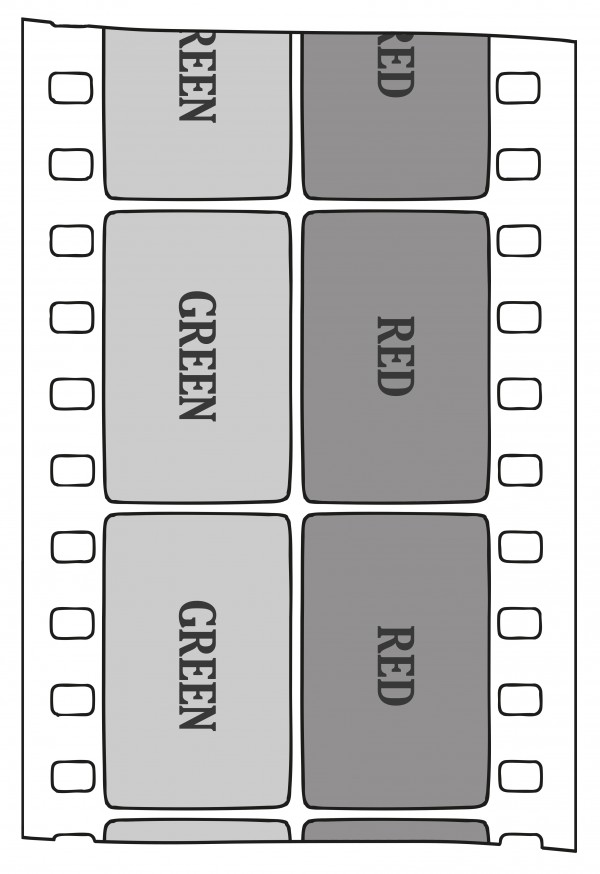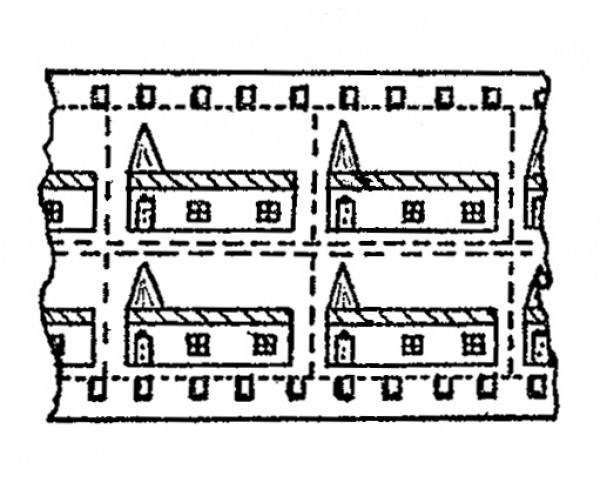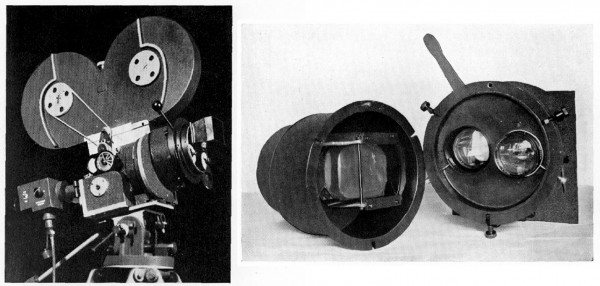A British two-color additive system. A continuation of the Cinechrome process.
Film Explorer

The British Cinecolor process captured two images simultaneously with a twin-lens camera. A beam-splitting prism then redirected the light and rotated the images 90-degrees, recording separate red and green records onto standard 35mm B/W panchromatic film using color filters. (The same color filters were also used during projection.) The film moved vertically in the camera and projector, but had a horizontal orientation on the film.
Design by Christian Zavanaiu.
Identification
Unknown
Approx.
B/W
1
British Cinecolor was an additive, two-color process using red and green component colors. Both the camera negative and the projection print used B/W film in combination with color filters on the lenses. In projection, the two color records were superimposed on the screen to recreate a color image.
Approximately 18mm x 12mm (0.735 in x 0.490 in) for the first version of the process; approximately 12mm x 8mm (0.472 in x 0.315 in) for the second version of the process.
The film was advanced vertically in the camera, however in an early version of the process the images were oriented on the film horizontally.
B/W, panchromatic.
History
Cinecolor was an additive process spearheaded by the engineers Samuel James Cox, Demetre Daponte and John Hendri Dowell.
Cox was a prolific inventor of color processes in Britain, well known for his 1914 patent (GB191415648A) describing three-color toning. Later, he worked for Cinechrome Ltd, where he improved a process initially developed by Colin Noel Bennett. He proposed using 70mm film for exposing two color records, with standard apertures, side-by-side on the wide film strip. This invention was used for the only completed Cinechrome films that documented the visit of the Prince of Wales to India during 1921–22.
Romanian inventor Demetre Daponte (also known as Dimitru Daponte, Demetrius Leonida Daponte and Demetre Da Ponte) worked for Adam Hilger Ltd, an optical instruments company that was also involved in the development of Cinechrome. Daponte was known for Pulsograph, a projector for stereoscopic cinema, which he proposed in 1924 (US1714849A). The device was surprisingly similar to Cox's Cinechrome color process – however, instead of capturing two color records side-by-side, it recorded a pair of stereoscopic images side-by-side on 70mm film.
After the death of Cinechrome investor and jam industrialist Sir William Pickles Hartley in 1922, Cox and Daponte ran Cinechrome for some time. However, they later decided to form a separate company to exploit their new patents and Cinecolor Ltd was incorporated in London in 1929.
Sir Percy Malcolm Stewart, a prominent brick manufacturer, became the primary investor for the new process and D. Harrison of the Gerrard Wire Engineering Co was appointed managing director. Using the faintly patriotic slogan – “the only color process purely British in origin” – Cinecolor entered the market in late 1929 (Film Daily, 1929).
Demetre Daponte's 1930 patents (GB346406A, GB346454A) formed the basis for the newly rebranded color process. John Hendri Dowell, another Adam Hilger Ltd employee, later contributed to the refinement of the process with a series of proposed improvements to the beam-splitting prism used for two-color and three-color photography.
In February 1930, Daponte presented the process in New York. In late 1930, Warner Bros., which was using two-color Technicolor at that time but likely searching for alternatives, ordered five Cinecolor test cameras from London. Cinecolor also registered an American office as Cinecolor Company of America Inc. in Delaware. This company should not be confused with Cinecolor, Inc., the widely used subtractive two-color process with laboratories in Burbank, California.
British Cinecolor was apparently recognized at the time for its color precision and delicacy, avoiding parallax and fringing effects (Cornwell-Clyne, 1951: p. 271). However, the process is not known to have been used on any commercial productions.
In 1936, Chromex Ltd acquired the patents of Cinecolor Ltd and merged the company with its other subsidiaries Dufaycolor Ltd, Dufaycolor Corporation and Spicer-Dufay Ltd, to establish Dufay-Chromex. Daponte also joined the new company.
Technology
Cinecolor was a two-color additive system that used standard 35mm film and a beam-splitting prism in the camera and projector.
The main feature of the system was the positioning of the images on the 35mm film. Thanks to an “ingenious prism erecting device” (Cornwell-Clyne, 1951: p. 271), two color records (red and green) were taken simultaneously on B/W film, but they were turned sideways so that the area of the standard film frame contained two wide images about 18mm x 12mm (0.735 in x 0.490 in) in size. Later, the system captured two small images side-by-side about 12mm x 8mm (0.472 in x 0.315 in) in size, which were placed in the center of the full frame, similar, but with a different arrangement, to the Raycol or Francita processes.
Cinecolor films used a 35mm Vinten camera. The camera’s optical mechanism used an array of prisms placed within the lens mount. The prisms could be meticulously adjusted to avoid parallax.
Similar to the camera, the projector also required a beam-splitting prism attachment and lenses with color filters. This prism was adjustable to achieve the perfect superimposition of the two color records on-screen. Marketing materials emphasized that the projector attachment was designed to allow for easy switching between color and B/W modes.

Two images were taken simultaneously with a twin-lens camera. A beam-splitting prism redirected the light and rotated the images 90-degrees, capturing separate red and green records onto standard 35mm B/W panchromatic film using color filters. (The same color filters were also used during the projection of a print made from the negative.) The film moved vertically in the camera, but had a horizontal orientation on the film.
Da Ponte, Demetre. Process of Producing Cinematographic Effects in Colours and Means therefor. GB346406A, filed Jan. 9, 1930, granted Apr 9, 1931.

The British Cinecolor camera by Vinten Ltd and Adam Hilger Ltd (left); British Cinecolor lens and prism unit, constructed by Adam Hilger Ltd (right).
Cornwell-Clyne (1951). Colour Cinematography. London: Chapman & Hall., p. 273.
References
American Cinematographer (1930). “British Color Process Sought by Warner Bros”. American Cinematographer, 11:5 (Sep.): p. 31.
Anon. (1930). “Film Color Processes. May 30, 1930”: pp. 16–18. Box 50, “Miscellaneous” folder. Earl I. Sponable Papers. Rare Book and Manuscript Library, Columbia University Libraries, New York, NY.
Brown, Simon (2012). “Technical Appendix”. In Colour Films in Britain: The Negotiation of Innovation 1900–55, Sarah Street (ed.), pp. 266–8. Basingstoke: Palgrave Macmillan.
Cornwell-Clyne, Adrian (1951). Colour Cinematography (3rd Edn). London: Chapman & Hall.
Film Daily (1929). “New Film Color Process is Developed in Britain”. The Film Daily, 50:52 (Dec. 1): p. 12.
Film Daily (1930). “British Color Process Sought by Warner Bros”. The Film Daily, 53:41 (Aug. 18): pp. 1–2.
Film Daily (1936). “The Foreign Field”. The Film Daily. 69:37 (Feb. 13): p. 10.
Kelley, W. V. D. (1925). “Color Photography Patents”. Transactions of the Society of Motion Picture Engineers, 21 (May 18–21): pp. 113–18.
Motion Picture News (1926). “Resume of Progress in Industry During 1925”. Motion Picture News, 33:10 (Mar 6): p. 1124.
Motion Picture News (1929). “Cinecolor, British Process, About to Take Its Debut”. Motion Picture News (Dec. 21): p. 12.
Spencer, D. A. (1935). “Progress in Colour Photography”. The Photographic Journal, 75: p. 199.
Spencer, D. A. (1937). “Progress in Colour Photography”. The Photographic Journal, 77: p. 228.
Raimondo-Souto, H. Mario (2006). Motion Picture Photography: A History, 1891–1960. Jefferson, NC: McFarland, p. 210.
Patents
Adam Hilger Ltd, John Hendri Dowell. Improvements in or Relating to Colour Photography and Projection. GB388754A, filed Aug. 29, 1930, granted Feb 28, 1933.
Adam Hilger Ltd, John Hendri Dowell. Improvements in Optical System for the Projection of Erected Images. GB394385A, filed Sep. 26, 1932, granted Jun. 26, 1933.
Bennett, Colin Noel, Conrad Beck. Improvements in Apparatus for taking or Projecting Photographic Pictures. British Patent 24,159, filed Oct. 22, 1912; granted Oct. 22, 1913.
Da Ponte, Demetre. Process of Producing Cinematographic Effects in Colours and Means therefor. GB346406A, filed Jan. 9, 1930, granted Apr 9, 1931.
Da Ponte, Demetre. Process of Producing Cinematographic Effects in Colours and Means therefor. GB346454A, filed Jan. 9, 1930, granted Apr 9, 1931.
Dowell, John Hendri, Adam Hilger Ltd. Improvements in Cameras for Colour Photography. GB349107A, filed Jan. 18, 1930, granted May 18, 1931.
Dowell, John Hendri. Camera for Color Photography. US1839955A, filed Jan. 20, 1931, granted Jan 5, 1932.
Daponte, Demetre. Optical Light Dividing System. US1945029A, filed Jan. 8, 1930, granted Jan 30, 1934.
Dowell, John Hendri, Adam Hilger Ltd. Improvements in cameras for colour photography. GB427983A, filed Nov. 11, 1933, granted May 3, 1935.
Preceded by
Compare
Related entries
Author
Oleksandr Teliuk is a film scholar, archivist and artist. As a film archivist and programmer, he worked at the Dovzhenko Center, Ukrainian State Film Archive. He was co-curator of film programmes and exhibitions at the Film Museum of Dovzhenko Center, including “VUFKU: Lost & Found” (2019); co-editor of books (Cinematographic Revision of Donbas [2017, 2018], Chornobyl (In)Visible [2017] and Ukrainian Film Critic Anthology of the 1920s [2018—2022]); curator of numerous film programmes of Ukrainian archival cinema at international film festivals. He is a graduate of the L. Jeffrey Selznick School of Film Preservation (2024).
Teliuk, Oleksandr (2024). “British Cinecolor”. In James Layton (ed.), Film Atlas. www.filmatlas.com. Brussels: International Federation of Film Archives / Rochester, NY: George Eastman Museum.


